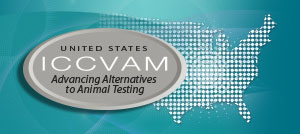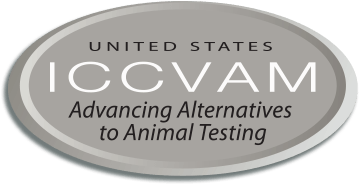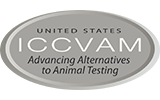Efforts by individual countries to develop new approach methodologies will have little impact without international adoption of the new methods. To advance international adoption, ICCVAM and its member agencies interact frequently with international partners to facilitate harmonization and regulatory acceptance.
International Interactions
Contributions to OECD activities
ICCVAM member agencies participate in the development and review of chemical testing guidelines issued by the OECD Test Guidelines Programme. OECD test guidelines are used by government, industry, and independent laboratories of the 38 OECD member countries to assess chemical safety. The U.S. National Coordinators for the OECD Test Guidelines Programme, who are members of ICCVAM, solicit and collate U.S. comments on draft test guidelines, guidance documents, project proposals, workshop reports, and other documents of the Test Guidelines Programme. The National Coordinators represent the United States at the annual meeting of the Working Group of National Coordinators and in other test guideline development activities. One or more ICCVAM subject matter experts may join the U.S. National Coordinators at this meeting.
In 2022 and 2023, ICCVAM agencies commented on draft OECD documents through the U.S. National Coordinators. ICCVAM members and/or NICEATM staff also supported the Test Guidelines Programme during 2022 and 2023 by:
- Supporting OECD activities to revise Test Guidelines Programme resources and processes to better support uptake of emerging technologies. Workshops held in December 2022 and December 2023 focused on how to prepare for emerging technologies and practical and financial aspects of validation studies, respectively. ICCVAM members assisted in organizing these meetings and provided expert participants.
- Co-leading a project and participating in an OECD expert group coordinating revision of Guidance Document 34 on validation and acceptance of new or updated test methods for hazard assessment. Revision of this document was also a key topic of discussion at the 2023 ICATM coordination meeting.
- Leading development of the OECD Omics Reporting Framework. This modular framework released in 2023 facilitates data sharing for toxicology experiments using various types omics approaches (i.e. transcriptomics, metabolomics), increases transparency of omics data processing and analysis approaches, enables quality assessments, promotes reproducibility in omics experiments, and fosters the uptake of omics data for use in regulatory processes (Harrill et al. 2021).
- Contributing to a proposal to update OECD Test Guideline 496 for in vitro test methods to identify eye irritants to add the OptiSafe test method to the guideline.
- Serving on an expert group developing a guideline for defined approaches for skin sensitization. This group supported the development of Guideline 497, Defined Approaches for Skin Sensitisation, issued in 2021. Guideline 497 is the first internationally harmonized guideline to describe a non-animal defined approach (DA) that can be used to replace an animal test to identify skin sensitizers. NICEATM and ICCVAM scientists are currently contributing to two proposals to update Guideline 497 to include new information sources for existing DAs, and new DAs for quantitative risk assessment.
- Participating in a group developing a Case Study on the Use of an IATA for Identifying Androgen Receptor Active Chemicals, which has been submitted to the OECD Working Party on Hazard Assessment.
- Serving on the Validation Management Group – Non-animal, which focuses on evaluation of new methods for identifying endocrine disruptors.
- Serving on an expert group considering test batteries for developmental neurotoxicity (DNT). NIEHS and EPA scientists developed a case study on application of IATAs for DNT, which was published by OECD in 2022. Expert group members also contributed to a 2023 guidance document on evaluating data from in vitro DNT test batteries.
- Participating on an expert group evaluating methods to assess thyroid disruption.
- Participating on an advisory group on emerging science in chemicals assessment.
Participation in the International Cooperation on Alternative Test Methods
The International Cooperation on Alternative Test Methods (ICATM) was created to foster dialog among national validation organizations. This dialog facilitates international cooperation in the critical areas of validation studies, independent peer review, and development of harmonized recommendations. ICATM includes member organizations from the European Union, United States, Japan, Canada, and South Korea. In recent years Brazil, China, Singapore, and Taiwan have participated in ICATM as observers.
ICATM Participant Organizations
- ICCVAM is an interagency committee of the U.S. government that coordinates technical reviews of alternative test methods and cross-agency activities relating to validation, acceptance, and harmonization of test methods. NICEATM administers ICCVAM and provides scientific support for its activities.
- EURL ECVAM (European Union Reference Laboratory for Alternatives to Animal Testing) is a unit within the Institute of Health and Consumer Protection in the European Union’s Joint Research Centre. EURL ECVAM coordinates the validation of alternative test methods in the European Union.
- JaCVAM (Japanese Center for the Validation of Alternative Methods) coordinates the evaluation of alternative test methods for the Japanese National Institute of Health Sciences, its parent organization.
- Health Canada’s Environmental Health Science and Research Bureau coordinates the evaluation of alternative test methods in Canada. The Canadian Centre for Alternatives to Animal Methods and its subsidiary, the Canadian Centre for the Validation of Alternative Methods, participate as partners with Health Canada in ICATM activities.
- KoCVAM (Korean Center for the Validation of Alternative Methods) is part of the National Institute of Food and Drug Safety Evaluation of the South Korean Food and Drug Administration.
- BraCVAM (Brazilian Center for the Validation of Alternative Methods) functions as the focal point within Brazil to identify or receive requests for test method validation. It works to implement appropriate validation studies with the National Network of Alternative Methods to the Use of Animals within the Brazilian Ministry of Science, Technology, Innovations, and Communications.
In most years, ICATM member organizations hold at least one coordination meeting. The most recent coordination meeting was convened in August 2023 in Niagara Falls, Canada, in conjunction with the 12th World Congress on Alternatives and Animal Use in the Life Sciences. Representatives from the United States, European Union, Canada, Japan, South Korea, Taiwan, Brazil, and the OECD Test Guidelines Programme met to discuss ongoing efforts to update OECD’s “Guidance Document on the Validation and International Acceptance of New or Updated Test Methods for Hazard Assessment,” informally known as “Guidance Document 34.”
Participants in the August 2023 ICATM coordination meeting felt that the traditional validation approach of conducting multi-laboratory ring trials to assess transferability and performance may not be practical for many new technologies upon which NAMs are based. Elements identified as key to successful validation included well-defined protocols that incorporate quality management principles; a diverse set of reference chemicals; clear acceptance criteria that consider standards other than prediction of in vivo animal data (e.g., human biological relevance); and coordinated peer review that minimizes duplication of effort.
ICATM representatives also attend or participate in meetings of the Scientific Advisory Committee on Alternative Toxicological Methods.
NICEATM participated in a peer review of a JaCVAM-coordinated validation study of the EpiSensA skin sensitization test method. The method utilizes a reconstructed human epidermis model to evaluate changes in gene expression of four markers of keratinocyte response to skin sensitizers, the second key event of the adverse outcome pathway for skin sensitization. A poster presented at the 2023 annual meeting of the Society of Toxicology (Reinke et al., Alternatives to Mammalian Models II session) summarized the validation study. The method will be under evaluation at OECD for inclusion in TG 442D in the 2024 review cycle. NICEATM and JaCVAM scientists and members of the EURL ECVAM advisory committee also participated in a peer review of the SENS-IS test method for skin sensitization.
The following ICCVAM workgroups had ICATM member liaison representatives during 2022 and 2023.
|
ICCVAM Workgroup |
ICATM Organizations with Liaison Members |
|---|---|
|
Acute Toxicity Workgroup |
EURL ECVAM |
|
In Vitro to In Vivo Extrapolation Workgroup |
JaCVAM |
|
Read Across Workgroup |
JaCVAM |
Participation on ICH
The FDA Center for Drug Evaluation and Research pursues international harmonization of nonclinical recommendations for pharmaceutical development through its engagement with the International Council for Harmonisation of Technical Requirements for Pharmaceuticals for Human Use (ICH). ICH brings together regulatory authorities and the pharmaceutical industry to discuss scientific and technical aspects of drug registration. ICH's mission is to achieve greater harmonization worldwide to ensure that safe, effective, and high-quality medicines are developed and registered in the most resource-efficient manner. These activities prevent repetition of studies and reduce and refine animal use in overall drug development. New guidance recently approved will continue to contribute to the 3Rs as will future guidance currently being developed or revised.
FDA published guidance aligned with ICH documents on carcinogenicity testing of pharmaceuticals as discussed elsewhere in this report.
Review of animal testing requirements in World Health Organization guidelines and recommendations for biologics
Biologics such as vaccines, cytokines, enzymes, and hormones are tested routinely after approval to ensure the safety and potency of products. Many of these tests use animals, and thus a large number of animals are used for biologics testing each year.
FDA and NIEHS are supporting a project led by the World Health Organization and NC3Rs to carry out an independent and comprehensive review of animal use requirements within World Health Organization guidelines for biologics and to make recommendations for where non-animal approaches can be adopted. The project began with a survey of biologics manufacturers to better understand the opportunities and barriers to adoption of replacement, reduction, and refinement (3Rs) alternatives and use of non-animal approaches in quality control, batch, and lot release testing of biologics. A similar survey of national regulatory authorities and national control laboratories was conducted in early 2022. A September 2022 virtual workshop focused on requirements in North and South America. Biologicals regulatory agencies and manufacturers from the region discussed their perspectives on current testing strategies and how changes to WHO guidelines could be implemented to support wider adoption of 3Rs and non-animal approaches. The findings from this project were presented to the World Health Organization Expert Committee on Biological Standardization in October 2023.
GHS non-animal testing working group
OSHA is leading the United States’ effort to update and expand the use of non-animal test data for GHS hazard classification. OSHA participated in meetings convened by the United Nations Subcommittee of Experts on the GHS in 2022 and 2023 to harmonize international standards on safe handling of chemicals. OSHA held multiple public meetings to receive input from U.S. stakeholders in advance of the international meetings. The update of GHS chapters on skin and eye corrosion/irritation was finalized in 2021 to reflect new in vitro test methods for classifying hazards as well as updating guidance on the use of data from in silico methods. Updates to the chapter on eye irritation included updated and expanded guidance on the use of in vitro and in silico test data for classification as well as introducing the use of DAs for use of data from multiple test methods. The work continued in 2022 with an update of skin sensitization, which also includes new in vitro test methods for classifying hazards as well as updating guidance on the use of data from in silico methods and use of DAs. OSHA anticipates the GHS will adopt the changes to the skin sensitization chapter by July 2024.



